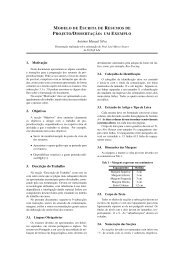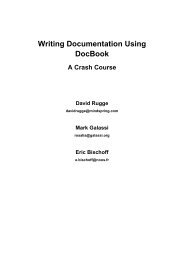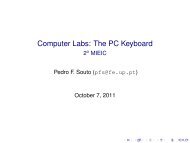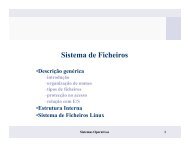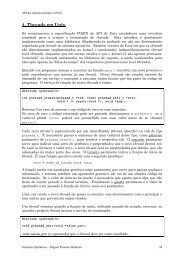Computer Labs The i8254 Timer/Counter
Computer Labs: The i8254 Timer/Counter - 2º MIEIC
Computer Labs: The i8254 Timer/Counter - 2º MIEIC
You also want an ePaper? Increase the reach of your titles
YUMPU automatically turns print PDFs into web optimized ePapers that Google loves.
<strong>Computer</strong> <strong>Labs</strong>: <strong>The</strong> <strong>i8254</strong> <strong>Timer</strong>/<strong>Counter</strong>2 o MIEICPedro F. Souto (pfs@fe.up.pt)October 3, 2012
Lab3: <strong>The</strong> PC’s <strong>Timer</strong>/<strong>Counter</strong>◮ Write a set of functions:int timer_test_square(unsigned long rate)int timer_test_int(unsigned long time)int speaker_test(unsigned long freq, unsigned long time)that require programming the PC’s <strong>Timer</strong>/<strong>Counter</strong>◮ <strong>The</strong>se functions are at a higher level than those of the previouslabs◮ <strong>The</strong> idea is that you design the lower level functions (with the finalproject in mind)◮ In this lab we have also defined the lower level functions◮ What’s new?◮ Program an I/O controller: the PC’s timer counter (<strong>i8254</strong>)◮ Use interrupts
<strong>The</strong> <strong>i8254</strong>◮ It is a programmable timer/counter◮ Each PC has a functionally equivalent circuit, nowadays it isintegrated in the so-called south-bridge◮ Allows to measure time in a precise way, independently ofthe processor speed◮ It has 3 16-bit counters, each of which◮◮May count either in binary or BCDHas 6 counting modes
<strong>i8254</strong> Block Diagram◮ Three independent 16-bitcounters◮ Ports 40h, 41h and 42h◮ MSB and LSB addressableseparately◮ 6 counting modes◮ An 8 bit-control register◮ Port 43h◮ Programming of each counterindependently
<strong>i8254</strong> Control Word◮ Written to the Control Register (0x43)Bit Value Function7,6 <strong>Counter</strong> selection00 001 110 25,4 <strong>Counter</strong> Initialization01 LSB10 MSB11 LSB followed by MSB3,2,1 Counting Mode000 0001 1x10 2x11 3100 4101 50 BCD0 Binary (16 bits)1 BCD (4 digits)Example◮ <strong>Timer</strong> 2 in mode 3◮ Couting value: 1234 = 0x04D2Control Register: 10111110<strong>Timer</strong>2 LSB 0xD2<strong>Timer</strong>2 MSB 0x04
<strong>i8254</strong> Counting ModesMode 0 Interrupt on terminal count – for counting events◮ OUT goes high and remains high when count reaches 0Mode 1 Hardware retriggerable one-shot◮ OUT goes low and remains low until count reaches 0, thecounter is reloaded on a rising edge of the ENABLE inputMode 2 Rate Generator (divide-by-N counter)◮ OUT goes low for one clock cycle when count reaches 0,the counter is reloaded with its initial count afterwards,and ...Mode 3 Square Wave Generator – for Lab 3◮ Similar to mode 2, except for the duty-cycle: OUT will behigh for half of the cycle and low for the remaining half ofthe cycle
<strong>i8254</strong>: Use in the PC (1/2)◮ <strong>Timer</strong> 0 is used to provide a time base.◮ <strong>Timer</strong> 1 is used for DRAM refresh◮ Via DMA channel 0(Not sure this is still true.)◮ <strong>Timer</strong> 2 is used for tone generation
<strong>i8254</strong>: Use in the PC (2/2)◮ <strong>The</strong> <strong>i8254</strong> is mapped in the I/0 address space:<strong>Timer</strong> 0:0x40<strong>Timer</strong> 1:0x41<strong>Timer</strong> 2:0x42Control Register: 0x43◮ Need to use IN/OUT assembly instructions◮ Minix 3 provides the SYS_DEVIO kernel call for doing I/O#include int sys_inb(port_t port, unsigned long *byte);int sys_outb(port_t port, unsigned long byte);◮ Need to write to the control register before accessing anyof the timers
Minix 3 and <strong>Timer</strong> 0◮ At start up, Minix 3 programs <strong>Timer</strong> 0 to generate a squarewave with a fixed frequency◮ <strong>Timer</strong> 0 will generate an interrupt at a fixed rate:◮ Its output is connected to IRQ0◮ Minix 3 uses these interrupts to measure time◮ <strong>The</strong> interrupt handler increments a global variable on everyinterrupt◮ <strong>The</strong> value of this variable increments at a fixed, known, rate◮ Minix 3 uses this variable mainly for:◮◮Keeping track of the date/timeImplementing SW timers
Lab 3: Part 1 - Generating a Square WaveWhat to do? Change the rate at which <strong>Timer</strong> 0 generatesinterrupts.int timer_test_square(unsigned long freq)1. Write control word to configure <strong>Timer</strong> 0:◮ Select square wave mode (mode 3)◮ Preferably, LSB followed by MSB2. Load <strong>Timer</strong> 0 with the value of the divisor to generatethe frequency corresponding to the desired rate◮ Depends on the previous stepHow to design it? Try to develop an API that can be used in theproject.int timer_set_square(unsigned char timer,unsigned long freq)How do we know it works? Use the date command.
Further Reading◮ Lab 3 Script◮ <strong>i8254</strong> Data-sheet



